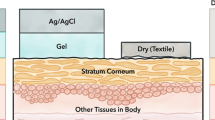Abstract
The aim is to compare the mean values of the in vivo electrical characteristics of bioiogical active points (BAPs) with those of the surrounding human skin. The impedance measurements at BAPs and on the surrounding skin are carried out in vivo on ten young, healthy people. The results of the measurements show that the BAP resistance RP is smaller, and the capacitance CP is higher, than the corresponding values for skin, RS and CS, respectively, these differences are larger at low frequencies (at f=3 Hz, RS/RP=3.19 and CP/CS=3.2). The mean values of the impedance measurements at the BAPs are different from those measured on the skin. The dependence of RP and CP on the pressing force, in the range of about 1–5 N, for the BAPs, has a smaller slope than that observed for the surrounding skin. An equivalent circuit for the BAPs is proposed that describes sufficiently well the experimental results obtained. These results show that the large dispersion in the observed impedance characteristics of the human body measurements in different body regions can be related to the influence of the BAPs present under the electrodes.
Similar content being viewed by others
References
Barber, D. C., Brown, B. H., andFreeston, I. L. (1983): ‘Imaging spatial distribution of resistivity using applied potential tomograpthy’,Electron. Lett.,19, pp. 933–935
Dorgan, S. J., andReilly, B. R. (1999): ‘A model for human skin impedance during surface function neuromuscular stimulation’,IEEE Trans. Rehab. Eng.,7, pp. 341–348
Griffiths, H. (1995): ‘Tissue spectroscopy with electrical impedance tomography: computer simulations’,IEEE Trans.,BME-42, pp. 948–954
Hannan, W. J., Cowen, S. J., Plester, C. E., Fearon, K. C. H., andDeBeau, A. (1995): ‘Comparison of bio-impedance spectroscopy and multi-frequency bio-impedance analysis for the assessment of extracellular and total body water in surgical patients’,Clinica Sci.,89, pp 651–658
Kalia, Y. N., andGuy, R. H. (1995): ‘The electrical characteristics of human skinin vivo’,Pharm. Res.,12, pp 1605–1613
Kalia, Y. N., Pirot, F., andGuy, R. H. (1996): ‘Homogeneous transport in a heterogeneous membrane: water diffusion across human stratum corneumin vivo’,Biophys. J., pp. 2692–2700
Katin, A. (1995): ‘Voll-method 2 plus’ (Quo Vadis, Vilnus)
Kontturi, K., Murtomaki, L., Hirvonen, J., Paronen, P., andUrtti, A. (1993): ‘Electrochemical characterization of human skin by impedance spectroscopy: the effect of penetration enchancers’,Pharm. Res.,10, pp. 381–385
Kontturi, K., andMurtomaki, L. (1994): ‘Impedance spectroscopy in human skin. A refined model’,Pharm. Res.,11, pp. 1355–1357
Kramer, F. (1972): ‘Elnfunrung in die Electroakupuntur nach Voll’ (Med.-Lit. Verlag, Uelzen)
Lanckermeier, A. H., McAdams, E. T., Moss, G. P., andWolfson, A. D. (1999): ‘In vivo impedance spectroscopy of human skin. Theory and problems in monitorning of passive percutaneous drug delivery’,Ann. New York Acad. Sci.,873, pp. 197–213
Leonhardt, H. S., andSarkisyanz, H. (1980): ‘Fundamentals of Electroacupuncture according to Voll: An Introduction’, (Med.-Lit. Verlag., Uelzen)
Macheret, E. L., andKorkushko, A. O. (1993): ‘Foundation of electro and acupuncture’ (Zdorov'e, Kiev)
McAdams, E. T., Jossinet, J., Lakermier, A., andRisacher, F. (1996): ‘Factors affecting electrode-gel-skin interface in electrical impedance tomography’,Med. Biol. Eng. Comput.,34, pp. 397–408
Nakatani, Y. (1956): ‘Skin electric resistance and ryodoraku’,J. Autonomic Nerve,6, p. 52
Portnov, F. G. (1987): ‘Electroacupuncture and reflex therapy’ (Zinatne, Riga)
Rosell, J., Colominas, J., Riu, P., Pallas-Areny, R., andWebster, J. G. (1988): ‘Skin impedance from 1 Hz to 1 MHz’,IEEE Trans.,BME-35, pp. 649–651
Sasser, D. C., Gerth, W. A., andWu, Y.-C. (1993): ‘Monitoring of segmental intra- and extracellular volume changes using electrical impedance spectroscopy’,J. Appl. Physiol.,74, pp. 2180–2187
Somasuk, I. A., andLisenko, V. P. (1994): ‘Acupuncture encyclopedia’ (Astpress, Kiev)
Voll, R. (1955): ‘Messbare Acupunctur-Diagnostic und Therapie fur den Praktier’,Erfahrungsheilkunde,4
Werner, F., Voll, R., andSchuldt, H. (1979): ‘Electro-acupuncture Primer’, (Med.-Lit. Verlag. Uelzen)
Author information
Authors and Affiliations
Corresponding author
Rights and permissions
About this article
Cite this article
Prokhorov, E.F., González-Hernández, J., Vorobiev, Y.V. et al. In vivo electrical characteristics of human skin, including at biological active points. Med. Biol. Eng. Comput. 38, 507–511 (2000). https://doi.org/10.1007/BF02345745
Received:
Accepted:
Issue Date:
DOI: https://doi.org/10.1007/BF02345745




